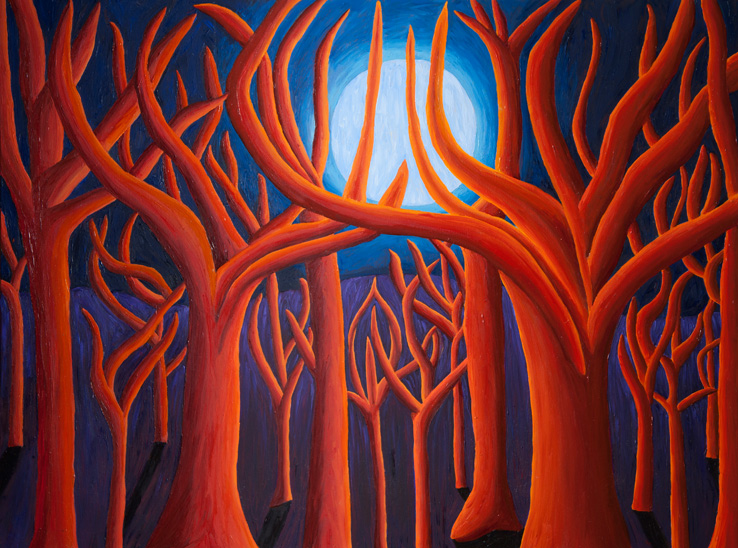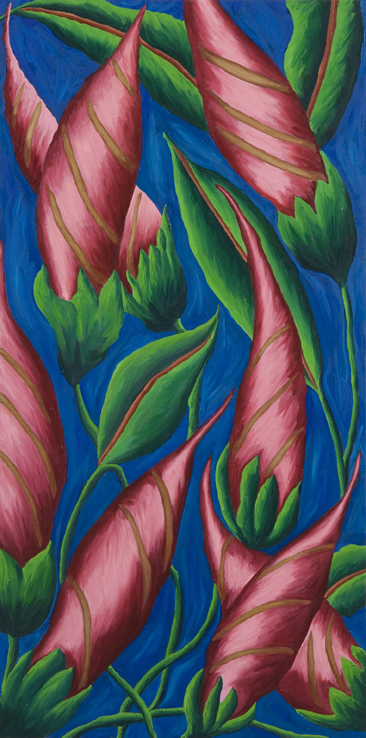
Teresa Parod is a painter, quilter, and the latest Evanston artist to be featured in our ongoing exhibition series Local Art @ EPL. Her colorful exhibit is currently on display on the 2nd floor of EPL’s Main Library where you can catch it through the end of March. Included are nearly two dozen paintings that express the challenges of our “everyday quest” through life and four, intricately-designed quilts that were created through a grant from the Judith Dawn Memorial Fund. We recently spoke with Ms. Parod via email about how her Aunt Marg sparked her interest in art, her use of shadow in her paintings, and the remarkable family that inspired her quilts.
Evanston Public Library: Can you tell us a little about your background as an artist? How did you get started in art? What drove you in the beginning? What drives you now?
Teresa Parod: The biggest influence in my becoming a painter was my Aunt Marg. In fact, Marg was not my aunt at all, but lived with my Aunt Ruth for 35 years until her death. I grew up on a farm in southern Illinois and beyond nature, there was little stimulus. Marg and Ruth visited most weeks. Marg was an enthusiastic and entertaining storyteller, and I was always amazed how she took the mundane and made it fabulous. I wanted to do this also. I do not know if I ever succeeded, but I do know she influenced my paradigm.
I have been fortunate to have traveled extensively. Direct images from my trips or the feel of places I have been are often included in my painting.

EPL: How do you describe your paintings? Can you take us through your creative process?
TP: A recurring and important theme in mythology is the quest for treasure or an idyllic place. What is searched for changes, but it is something that will benefit the individual or, more commonly, the community. The person who goes on the journey usually has adventures on the way and then returns. I am challenged everyday with quests. Not being called to fight dragons, my quests may seem less dramatic, although equally as difficult. Working on art, teaching, running a household, raising children, having a strong marriage and friendships, or simply trying to be a good person are some of my journeys to the ideal. I want my paintings to express these places these journeys lead to.
I use shadows because I think of my own shadow. I am not referring to negative elements, but I am considering facets of life I do not – or perhaps cannot – see without searching. I think of the shadow as a place or state and the most interesting place to be. In Indonesian shadow puppetry, an audience sits on one side of a shadow screen with puppeteers on the other. The audience is perceived to be in this world and the puppeteers in the spiritual. The shadow screen is the portal between. Perhaps this is the place to find the ideal.
I use repeated objects for a sense of predictability. I put repeated images in my paintings as anchors, as something stable and unchanging. Organic forms represent growth and sensuality. I rarely put people in my work because in most situations and times of my life, I am an outsider looking at groups of people I am not a part of. In works with architecture, I paint places where there are normally people, but people are absent. As is many situations, I feel there is something missing; something empty.
EPL: Can you tell us about the inspiration for your four quilts? What is the artistic element that links them?
TP: A former student and friend and her husband had a baby girl. My friend had many physical problems and was unable to have more children. The couple adopted a baby girl from China. A few years later I received an email with pictures of the entire family in Ethiopia. There were two Ethiopian girls with them. I correctly assumed that they were adopting them but did not want to write about it until all of the legal matters were finished.
The family is a remarkable! The girls are within four years of each other. They have faced challenges that all families face and challenges that are unique to their unique family. I respect their privacy and will not go into detail.
I made a quilt for each girl. I believe the girls can wrap themselves in their quilts and perhaps it will feel like a big hug or a big, “I love you.” They can have the quilts on their beds and know that their “Auntie TT” made the quilts for them to help them feel secure and warm, physically and emotionally.
I made each quilt using each girl’s favorite colors. The family celebrates their origins. I looked at a common theme in art from their heritage and ancestry. Along with China and Ethiopia, their ancestry includes Ireland. A type of design called interlacing is common in art from all three places. Interlacing can be done with many materials such as wood, metal, pen and paper, cords, etc. Lines or shapes appear to weave in and out in patterns. I used fabric and created interlaced patterns on each quilt.
EPL: What are your future goals and plans as an artist?
TP: My main goal is to make art. In addition to painting and quilting, I would like to create murals. I also plan to make books using collage.
Interview by Russell J.
